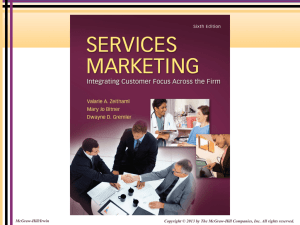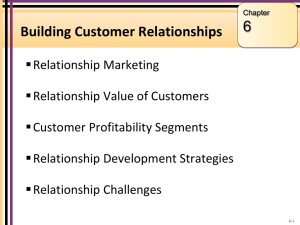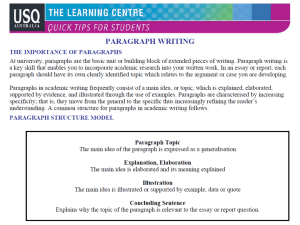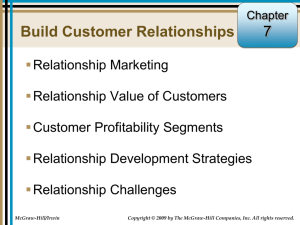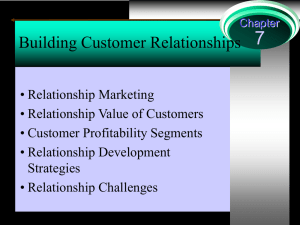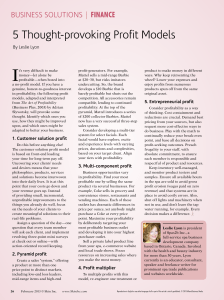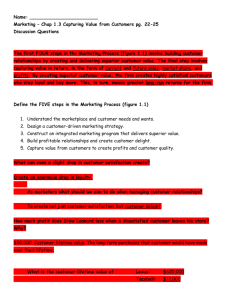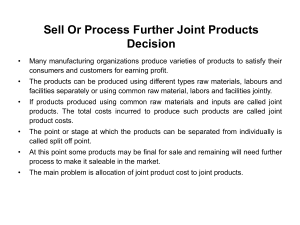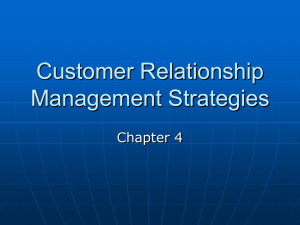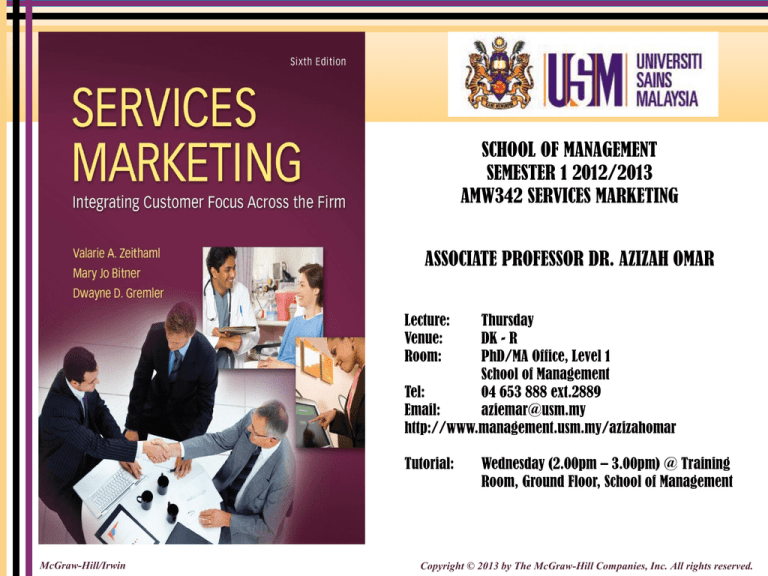
SCHOOL OF MANAGEMENT
SEMESTER 1 2012/2013
AMW342 SERVICES MARKETING
ASSOCIATE PROFESSOR DR. AZIZAH OMAR
Lecture:
Venue:
Room:
Thursday
DK - R
PhD/MA Office, Level 1
School of Management
Tel:
04 653 888 ext.2889
Email:
aziemar@usm.my
http://www.management.usm.my/azizahomar
Tutorial:
McGraw-Hill/Irwin
Wednesday (2.00pm – 3.00pm) @ Training
Room, Ground Floor, School of Management
Copyright © 2013 by The McGraw-Hill Companies, Inc. All rights reserved.
Chapter
Building Customer Relationships
6
Relationship Marketing
Relationship Value of Customers
Customer Profitability Segments
Relationship Development Strategies
Relationship Challenges
6-2
Objectives for Chapter 6:
Building Customer Relationships
Explain relationship marketing, its goals, and the benefits of long-term
relationships for firms and customers.
Explain why and how to estimate customer relationship value.
Introduce the concept of customer profitability segments as a strategy
for focusing relationship marketing efforts.
Present relationship development strategies—including quality core
service, switching barriers, and relationship bonds.
Identify challenges in relationship development, including the
somewhat controversial idea that “the customer is not always right.”
6-3
Relationship Marketing
is a philosophy of doing business, a strategic orientation, that
focuses on keeping current customers and improving
relationships with them
does not necessarily emphasize acquiring new customers
is usually cheaper (for the firm)
keeping a current customer costs less than attracting a new one
thus, the focus is less on attraction, and more on retention and
enhancement of customer relationships
6-4
The “Bucket Theory of Marketing”
6-5
Customer Goals of Relationship Marketing
6-6
Exhibit 6.1: A Typology of Exchange
Relationships
Customers as…
Strangers
Acquaintances
Friends
Partners
Product offering
Attractive relative to
competitors
On a par with
industry standards
Differentiated with
adaptation to
segments
Customized,
individualized
offerings
Source of competitive
advantage
Attractiveness
Satisfaction
Satisfaction + Trust
Satisfaction + Trust +
Commitment
Buying activity
(what customer does)
Interest, exploration,
trial
Reduced need for
search
Buying without
perfect information
Commitment in the
form of information
sharing, specific
investments
Focus of selling
activities (what firm
does)
Encouraging trial
facilitates initial
selling
Familiarity and
general knowledge
Specific segment
knowledge
Specific knowledge,
idiosyncratic
investments
Relationship time
horizon
None
Short
Medium: trust takes
time to build
Long: detailed
knowledge,
interconnections
Sustainability of
competitive
advantage
Low: must continue
to attract, induce trial
Low: must build
unique value into
standard product
Medium: must
understand various
customer needs
High: depends on
uniqueness &
effectiveness of
interconnections
Primary relationship
marketing goal
Acquire customer’s
business
Satisfy customer
needs
Retain customer’s
business
Enhance relationship
with customer
6-7
Benefits of Relationship Marketing
Benefits for Customers:
Receipt of greater value
Confidence benefits:
trust
confidence in provider
reduced anxiety
Social benefits:
familiarity
social support
personal relationships
Special treatment benefits:
special deals
price breaks
Benefits for Firms:
Economic benefits:
increased revenues
reduced marketing and administrative
costs
regular revenue stream
Customer behavior benefits:
strong word-of-mouth endorsements
customer voluntary performance
social benefits to other customers
mentors to other customers
Human resource management benefits:
easier jobs for employees
social benefits for employees
employee retention
6-8
Profit Generated by a Customer over Time
6-9
Customer Loyalty Exercise
Think of a service provider to whom you are
loyal.
What do you do (your behaviors, actions,
feelings) that indicates you are loyal?
Why are you loyal to this provider?
What factors have influenced the formation of
your loyalty?
6-10
Lifetime Value of a Customer
6-11
Figure 6.4: The Customer Pyramid
Most Profitable
Customers
Platinum
Gold
Iron
Lead
Least Profitable
Customers
What segment spends more with
us over time, costs less to maintain,
spreads positive word of mouth?
Not as
profitable:
discounts or
less loyal
Utilize capacity, but
do not merit special
treatment
What segment costs us in
time, effort and money yet
does not provide the return
we want? What segment is
difficult to do business with?
6-12
The Customer Pyramid
Platinum
Tier
Company’s most profitable customers, typically heavy users of
the product, not overly price sensitive, willing to invest in and try
new offerings, and committed customers of the firm
Gold Tier
Profitability levels are not as high, perhaps because customers
want price discounts that limit margins or are simply not as loyal.
May be heavy users who minimize risk by working with multiple
vendors.
Iron Tier
Essential customers that provide the volume needed to utilize the
firm'’ capacity but their spending levels, loyalty, and profitability
are not substantial enough for special treatment
Lead Tier
Customers who are costing the firm money. They demand more
attention than they are due given their spending and profitability
and are sometimes problem customers—complaining about the
firm to others and tying up firm resources.
6-13
Relationship Development Model
6-14
Strategies for Building Relationships
Core Service Provision:
service foundations built upon delivery of excellent service:
satisfaction, perceived service quality, perceived value
Switching Barriers:
customer inertia
switching costs:
set up costs, search costs, learning costs, contractual costs
Relationship Bonds:
financial bonds
social bonds
customization bonds
structural bonds
6-15
Levels of Relationship Strategies
6-16
“The Customer Is NOT Always Right”
Not all customers are good relationship
customers:
wrong segment
not profitable in the long term
difficult customers
6-17
Ending Business Relationships
Should firms fire their customers?
6-18
THANK YOU

